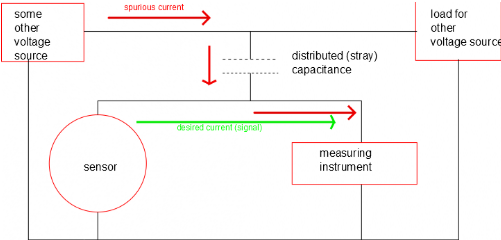US Patent 7,791,353 B2
Introduction
Simple Circuit Concepts
Transmission lines
Faraday's law
Near and far fields
Spurious coupling mechanisms
- Direct conduction
- Capacitive coupling -problem
- Capacitive coupling -fixing
- Inductive coupling-problem
- Inductive coupling -fixing by twisted
- Inductive coupling -fixing by coax
- Electromagnetic pickup
- Examples
- Safety & star grounding
- Gnd loop resistance, inductance
- Low frequency behavior
- High frequency behavior
- Troubleshooting
- Methods for removing
Spurious Coupling via capacitive pickup: the problem
Capacitive pickup, a vulnerability of high impedance circuits, is circumvented by shielding the signal wire. Any two separated conductors form a capacitor. The capacitance is C = 8.8A/d picofarads where A is the area of the conductors and d is their separation. Typical human-scale objects have capacitances of a few picofarads. Consider Fig. 5 where a signal from a sensor travels along conductors to a measuring instrument and there exists another voltage source referenced to the same common. Distributed stray capacitance exists between the signal conductor and the conductor connected to the other voltage source. The other voltage source injects a spurious current I = C d(DV)/dt onto the signal conductor where C is the stray capacitance, DV is the difference in voltages between the two conductors, and d(DV)/dt is the time rate of change of DV. This spurious current (red in Fig. 5) adds to the desired signal current (green in Fig. 5). For example, a 1 pF capacitance connected to a 1 volt pulse that has a 1 microsecond rise-time will inject 1 microampere of unwanted current into the signal circuit when the signal voltage is zero. If the circuit being contaminated is high impedance (i.e., signal current is low-current) this spuriously injected current will be significant and cause interference. On the other hand, if the circuit being contaminated is low impedance (i.e., signal current is high-current), the spuriously injected current will have minimal effect.
Capacitive pickup, a vulnerability of high impedance circuits, is circumvented by shielding the signal wire. Any two separated conductors form a capacitor. The capacitance is C = 8.8A/d picofarads where A is the area of the conductors and d is their separation. Typical human-scale objects have capacitances of a few picofarads. Consider Fig. 5 where a signal from a sensor travels along conductors to a measuring instrument and there exists another voltage source referenced to the same common. Distributed stray capacitance exists between the signal conductor and the conductor connected to the other voltage source. The other voltage source injects a spurious current I = C d(DV)/dt onto the signal conductor where C is the stray capacitance, DV is the difference in voltages between the two conductors, and d(DV)/dt is the time rate of change of DV. This spurious current (red in Fig. 5) adds to the desired signal current (green in Fig. 5). For example, a 1 pF capacitance connected to a 1 volt pulse that has a 1 microsecond rise-time will inject 1 microampere of unwanted current into the signal circuit when the signal voltage is zero. If the circuit being contaminated is high impedance (i.e., signal current is low-current) this spuriously injected current will be significant and cause interference. On the other hand, if the circuit being contaminated is low impedance (i.e., signal current is high-current), the spuriously injected current will have minimal effect.
Find ground loops fast!
-eliminate electical interference, fix star grounding
-eliminate electical interference, fix star grounding
US Patent 7,791,353 B2

Fig. 5 Spurious current I =Cd(DV)/dt shown as red from external voltage V couples through stray capacitance C and adds to desired signal current which is shown as green.
For quotes, purchase orders, shipping outside USA, questions contact
Circuit Insights LLC, Pasadena, California, USA
Email: sales@loopslooth.com Tel: 626-201-0488